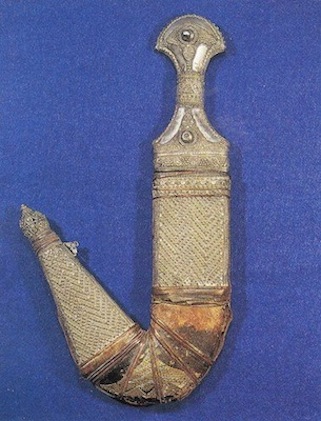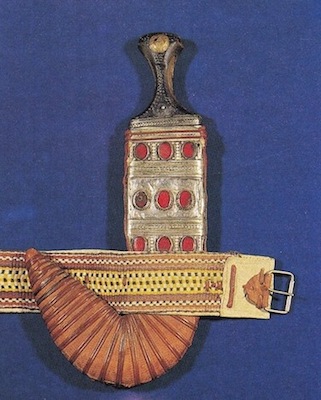Weapons - Curved Dagger (Jambiyah)
Material: horn, silver applications
Size: handle: 40 cm, blade: 21 cm, sheath: 24 cm
Silver, brass, gild, red velvet, leather
Museum of Ethnology, Vienna - Catalogue of the exhibition (Im Land der Königin von Saba) 1989/90
Private Collection
The curved dagger (in English also spelled Janbiya, Janbia or Jambia) is a historic weapon still encountered in Yemen, where it has become one of the main cultural assets. In line with tradition, the blacksmith forges the blade, the handle-maker fabricates the handle (traditionally gold and horn) and the sheath-maker and the belt-maker are in charge of the sheath and the belt, respectively. To Yemeni people, the handle comes first in importance and only in a second process consideration is given to the blade and the sheath. Costs vary, depending on the details of the handicraft ordered, and how much attention was in general dedicated to the fabrication of such a jambiyah. The most expensive, and also the rarest pieces have a blade made of carefully forged massive steel, an equally precious sheath made of leather or silver, and finally, an elaborately embroidered belt.
The jambiyah has a very long tradition in Yemen. In former times, caravan traders used to deal with jambiyahs. They have been worn by Yemeni men for thousands of years, one generation of men passing on their coveted jambiyahs to the next one. They are regarded as a sign of loyalty to the respective tribe, demonstrate social prestige, and have become an object of cultural value.
Their original significance has changed. The dagger no longer represents the power of the weapon as such, but rather it embodies freedom and virility. Furthermore, it is worthwhile to note that it is not allowed to wear jambiyahs (i.e. the blade) in official buildings (and this also applies to the ministerial staff!) or in hospitals and they have to be deposited by the owner at the entrance of such buildings (the sheath remains on the belt).
Even though jambiyahs ready for use may be purchased in numerous stores and nowadays also at the suq (a very popular acquisition by tourists), it remains an interesting phenomenon that Yemeni people prefer to carefully and never in a haste choose the individual components (belt, sheath and dagger) at the suq. The result is an individual curved dagger so as to possess a unique specimen.
Two further specimens are shown to present a fraction of the abundance of different models encountered.


